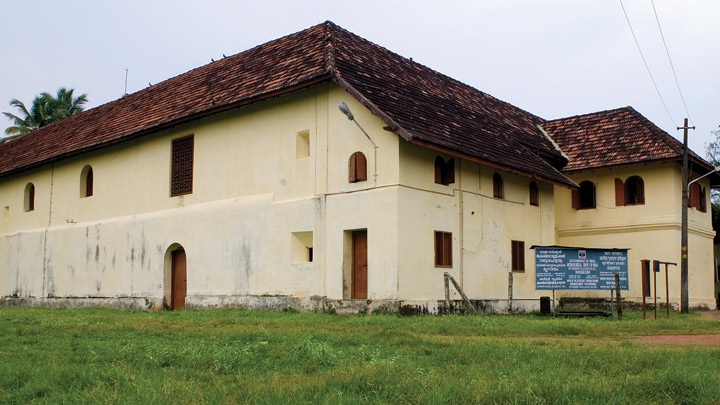Dutch Palace │Mattancherry Palace
Mattancherry, Kochi, Kerala 682002
Phone: 0484 606 8716

The Mattancherry Palace is a Portuguese palace popularly known as the Dutch Palace, in Mattancherry, Kochi, in the Indian state of Kerala which features Kerala murals depicting portraits and exhibits of the Rajas of Kochi.
History
The Mattancherry Palace was built and gifted by the Portuguese as a present to the king of Cochin around 1555. The Dutch carried out some extensions and renovations in the palace in 1663, and thereafter it was popularly called Dutch Palace. The rajas also made more improvements to it. Today, it is a portrait gallery of the Cochin Rajas and notable for some of the best mythological murals in India, which are in the best traditions of Hindu temple art. The palace was built to appease the king after they plundered a temple nearby.
The landing of Vasco da Gama, the Portuguese explorer at Kappad in 1498 was welcomed by the Kochi rulers. They were given exclusive right to construct factories. The Portuguese repulsed the repeated attacks of the Zamorians and the Cochin Rajas practically became vassals of the Portuguese. The influence of the Portuguese were supplanted by the Dutch and they took over Mattancherry in 1663. Subsequently, the area was taken over by Hyder Ali and still later by the British East India Company
The Palace
The Mattancherry palace is a quadrangular structure built in Nālukettu style, the traditional Kerala style of architecture, with a courtyard in the middle. In the courtyard there stands a small temple dedicated to ‘Pazhayannur Bhagavati’, the protective goddess of the Kochi royal family. There are two more temples on either side of the Palace, one dedicated to Lord Krishna and the other to Lord Siva. Certain elements of architecture, as for example the nature of its arches and the proportion of its chambers are indicative of European influence in basic Nālukettu style.
The Dining Hall has carved wooden ornate ceiling decorated with a series of brass cups. The palace also contains rare examples of traditional Kerala flooring, which looks like polished black marble but is actually a mixture of burned coconut shells, charcoal, lime, plant juices and egg whites.
Murals
The glory of the Mattancherry palace rests on the large number of murals, executed in the best traditions of Hindu temple art, which are religious, decorative and stylised. The murals have been painted in rich warm colours in tempera technique.
The king’s bedchamber or Palliyara, to the left of the entrance and occupying the southwest corner of the Palace, is noteworthy with its low wooden ceiling and 300 sq ft (28 m2) of wall surface covered with about 48 paintings. These illustrate the Ramayana, from the beginning of the sacrifice of Dasaratha to Sita’s return from captivity in Lanka. The paintings in this section are the earliest in the palace, dating back to the 16th century. The last five scenes are from the ‘Krishna Lila’ where in a cheerful God Krishna using his six hands and two feet to engage in foreplay with eight happy milkmaids. The paintings are attributed to the artistic bent of mind of Veera Kerala Verma.
The upper staircase rooms, notably that of the coronation hall that was extended under Dutch patronage, contain some murals. The notable compositions in this section are – Lakshmi seated on the lotus, sleeping Vishnu (Ananthasayanamurti), Shiva and Parvati seated with Ardhanariswara and other goddesses, the coronation of Rama, and Krishna lifting Mount Govardhana.
On the opposite side of the coronation hall is the staircase room or Kovinithalam (Room No II), with a descent to the lower storey, there are four paintings of Shiva, Vishnu and Devi, and one incomplete. Room No. IV depict scenes from Kumarasambhava and other works of the great Sanskrit poet Kālidāsa. The latter set of paintings belong to the eighteenth century.
Other exhibits
Portraits of the Rajas of Cochin, from 1864 onwards, are displayed in what was once the Coronation Hall. These were painted by local artists in western style. The ceiling of the hall is decorated with floral designs in wood craft.
Amongst the other exhibits in the palace are an ivory palanquin, a howdah, royal umbrellas, ceremonial dress used by the royalty, coins, stamps and drawings.
Source : wikipedia
https://www.youtube.com/watch?v=1WrJF9kiEJY
https://www.youtube.com/watch?v=MriE1AHulEI
Reviews
https://goo.gl/PnNero
Visiting hours : 10.00AM to 05.00PM ( Friday Closed )
Entry fee : Rs.2/- per person


Rate this article